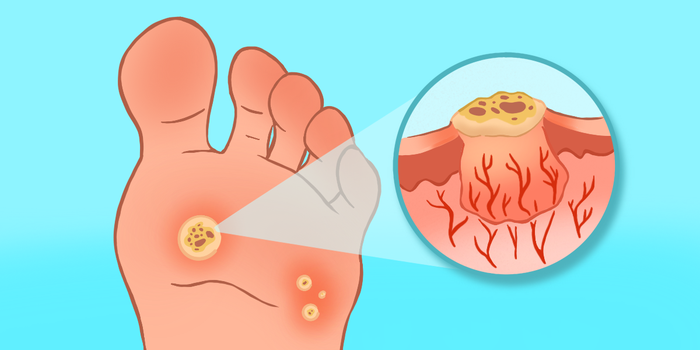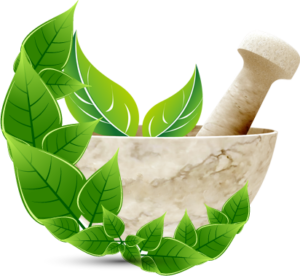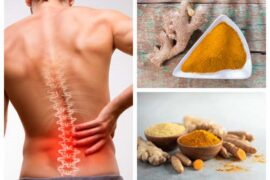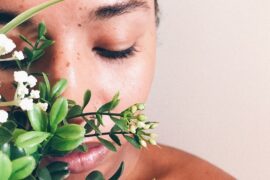Weary of Warts?

A clear skin makes you feel fresh. Even a small mark on skin leaves you very disturbed. One such mark that gets you worried is a wart.
What is a Wart?
Warts are small rough growths resembling blisters that develop on a person’s skin, most often on the skin of the hands or feet. Warts are also called as Verrucae. Human Papilloma Virus (HPV) is one of the common causes for the warts and most people will experience this infection at some point in their life. The Ayurveda equivalent of wart is Charmakeela.
Warts are of many kinds:
- Common wart (Verruca vulgaris): Is a raised wart with rough surface and occurs most commonly on hands and knees.
- Flat wart (Verruca plana): Is a small, smooth, and flattened wart, usually coffee or flesh colored. It may occur in large numbers, mostly on face, neck, hands, wrists, and knees.
- Digitate wart (Filiform wart): Is a thread or finger-like wart which is most common on the face, especially near the eyelids and lips.
- Plantar wart (Verruca pedis): Is a hardened kind of wart, and is sometimes painful. Often with multiple black specks in the center, it is usually found on pressure points on the soles of the feet.
- Mosaic warts: Are closely clustered plantar-type warts that are commonly found on the hands or soles of the feet.
- Genital wart (venereal wart, condyloma acuminatum, verruca acuminata): Is one that affects the genital areas.
Warts are the most common among dermatological ailments. Many people do not understand what to do and how to get rid of warts. Removing warts from the skin is an agonizing task, for it often leaves scars on the skin.
Before going into some of the home remedies and treatment options in Ayurveda, it is very important to consult a doctor to diagnose a wart. It is necessary to differentiate these warts from squamous cell carcinoma, molluscum contagiosum, epidermodysplasia verruciformis, callus, arsenic keratosis, and syphilis. Many a time, squamous cell carcinoma is wrongly construed to be a common wart. A doctor would help you in diagnosing it properly.
Hygiene
Strict hygiene is of utmost importance in the management of warts, especially when you treat them yourselves. Never leave a wart wet; dry is immediately after wash, for a wet wart may proliferate!
Although HPVs are usually restricted to a single part of the body, some of them can spread. Touching a wart and then touching another part of your body could give rise to new warts. Hence affected people should avoid physical contact with other people and with the unaffected part of one’s own body. Transmission of most wart infections, though improbable, is not impossible. Hence caution is to be exercised, especially in the case of genital warts. At times a wart can disappear on its own! It can also be painful and needs to be treated soon.

Ayurvedic Treatment for warts
- Kaseesadi Taila – Direct application of Kaseesadi taila on wart and covering with a cotton bandage will remove wart quickly.
- Garlic – Make a paste of garlic and apply on the wart and cover with a cotton bandage and wash the area with cold water after 4-6 hours. This will help in removal of wart. Doing this for a few days will help in complete removal of a wart.
- Amalaki or Amla is another medicine which helps in removal of warts. Applying of the juice of amla on wart for a week will help in curing of wart.
- Sap of banyan, papaya and fig is also an excellent medicine in wart removal.
- Castor oil can be applied regularly on the warts. This will help the warts to become supple and finally disappear. Instead of castor oil, camphor oil can be used in the same manner.
- Ksharasutra – Ayurveda Doctor would help in removal of warts with the help of ksharasutra.
Some Home remedies
- Hair – Tying of hair tightly around the base of the wart will check blood supply to the wart and will cause the wart to wither in 3 to 4 days without leaving a scar.
- Apply a compress or cotton ball soaked in vinegar and tape it down on the wart with an elastic bandage for at least one or two hours daily for effective removal.
- A popular folk remedy is to rub a juicy, freshly cut slice of raw potato over a wart.
- Take the peel of a banana and keep its inner side on the warts. Tie it up like a bandage. Change it twice a day. Do this until the wart disappears.
- Vitamin E oil is also said to work against warts. Once a day, pierce a vitamin E capsule and rub the contents on the warts.
- Plantar warts are painful warts on the bottom of your feet and are sensitive to heat and may disappear in a few weeks if you soak your feet in hot water (43˚C to 45˚C) for about 15 minutes a day. This remedy was published in a medical journal in the 1960s. For a better result you can add one part of vinegar or rock salt to hot water.
Diet for Warts
Proper and healthy diet plan is important for curing warts. Along with the above said remedies, patient should take fruits like papaya, orange and mangoes, and vegetables, especially green leafy vegetable regularly. Using of garlic, onion, egg, asparagus also helps in wart treatment.
For painless removal of warts with the help of Agnikarma or Ksharasutra, contact our Ayurvedic surgeons at I-AIM Healthcare, www.iaimhealthcare.org



